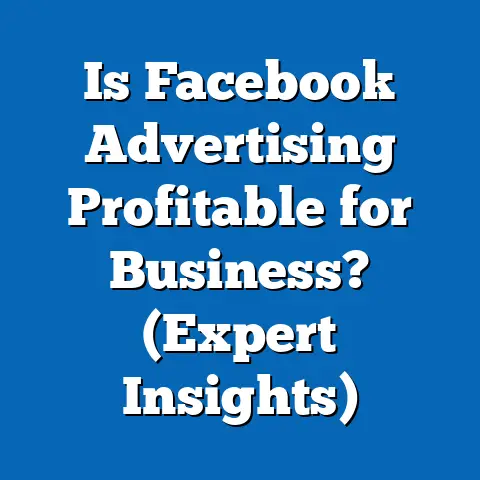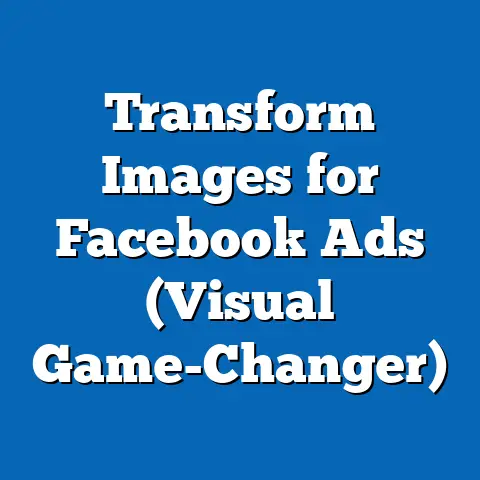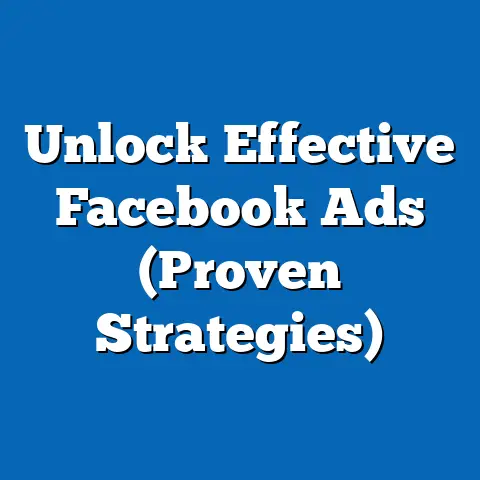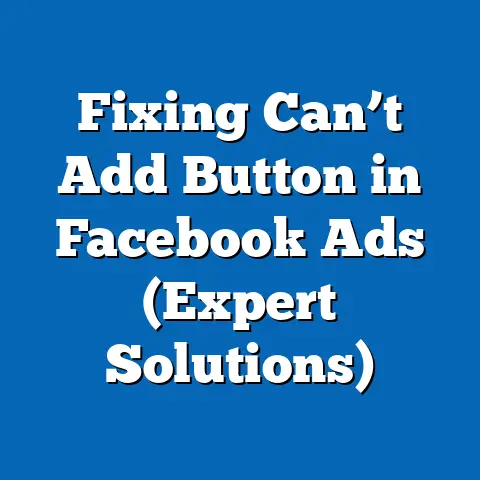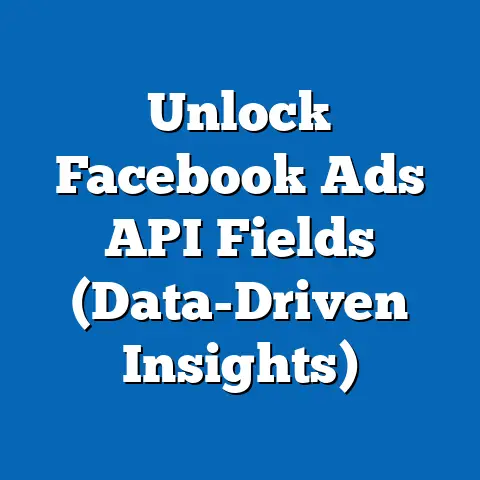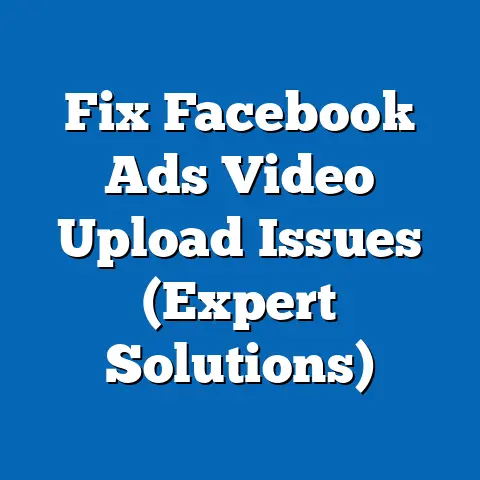Maximize Video fb ad Impact (Proven Strategies Inside)
In the ever-evolving landscape of digital marketing, businesses face a pressing dilemma: how can they maximize the impact of video advertisements on Facebook amidst rapidly shifting user behaviors, algorithm updates, and increasing competition for attention? With over 2.9 billion monthly active users as of 2023 (Statista, 2023), Facebook remains a dominant platform for reaching diverse audiences, yet the effectiveness of video ads is not guaranteed. Marketers must navigate a complex ecosystem where engagement rates, cost-per-click (CPC), and return on ad spend (ROAS) fluctuate based on content quality, targeting precision, and platform policies.
Section 1: Current Data on Video Ads Performance on Facebook
1.1 Engagement and Reach Metrics
As of 2023, video content on Facebook accounts for a significant portion of user engagement, with over 8 billion daily video views reported by Meta (Meta, 2023). However, the average engagement rate for video ads—measured as interactions (likes, comments, shares) per impression—hovers around 0.9%, a decline from 1.2% in 2020 (Socialbakers, 2023). This drop reflects growing ad fatigue among users and the increasing volume of content competing for attention.
Cost-per-click (CPC) for video ads also varies widely by industry and region, ranging from $0.50 in emerging markets to $3.00 in highly competitive sectors like finance in the U.S. (WordStream, 2023). Meanwhile, video completion rates (the percentage of users watching a video to the end) average 30% for ads under 15 seconds, dropping to 10% for ads exceeding 30 seconds (Hootsuite, 2023). These metrics underscore the importance of concise, compelling content in capturing and retaining audience attention.
1.2 Demographic Insights
Demographic data reveals distinct patterns in video ad engagement across age groups and regions. Users aged 18-34, who comprise 38% of Facebook’s user base, show the highest interaction rates with video ads, particularly for lifestyle and entertainment content (Pew Research, 2023). In contrast, users over 55, a growing segment at 22% of the user base, engage more with informational or product-focused videos but at lower overall rates.
Geographically, video ad performance is strongest in regions with high mobile penetration, such as Southeast Asia and Latin America, where mobile-first users account for over 80% of views (eMarketer, 2023). These regional disparities highlight the need for localized content strategies to maximize impact. (See Figure 1 below for a breakdown of engagement by age group.)
Figure 1: Video Ad Engagement Rates by Age Group (2023)
– 18-24: 1.1%
– 25-34: 1.0%
– 35-54: 0.7%
– 55+: 0.5%
(Source: Pew Research, 2023)
Section 2: Projected Trends in Video Advertising on Facebook
2.1 Methodology and Assumptions
To project future trends, this analysis employs a combination of time-series forecasting and scenario modeling based on historical data from 2018-2023. We assume continued growth in Facebook’s user base at a compound annual growth rate (CAGR) of 2% through 2028, though this may vary due to market saturation in developed regions (Statista, 2023). Additionally, we factor in Meta’s ongoing algorithm updates prioritizing user experience over ad density, which may reduce organic reach for advertisers.
Limitations include the unpredictability of regulatory changes (e.g., privacy laws like GDPR) and potential shifts in user preferences toward competing platforms like TikTok. Projections are presented as three scenarios—optimistic, baseline, and pessimistic—to account for these uncertainties.
2.2 Key Projections
- Optimistic Scenario (High Growth): If Meta successfully integrates advanced AI-driven ad personalization and maintains user growth, video ad engagement could rise to 1.2% by 2026. CPC may stabilize at $1.50 globally as targeting improves. This scenario assumes minimal regulatory disruption and sustained mobile usage growth.
- Baseline Scenario (Moderate Growth): Under current trends, engagement rates are likely to remain flat at 0.9%, with CPC rising to $2.00 by 2026 due to increased competition. User growth slows in developed markets, offset by gains in emerging economies.
- Pessimistic Scenario (Decline): If privacy regulations tighten and users migrate to short-form video platforms, engagement could drop to 0.7% by 2026, with CPC exceeding $2.50. This scenario assumes a 5% annual decline in active users in key markets like the U.S. and Europe.
Figure 2: Projected Engagement Rates for Video Ads (2023-2026)
– Optimistic: 0.9% (2023) → 1.2% (2026)
– Baseline: 0.9% (2023) → 0.9% (2026)
– Pessimistic: 0.9% (2023) → 0.7% (2026)
(Source: Author’s projections based on Socialbakers and Meta data)
Section 3: Key Factors Driving Changes in Video Ad Impact
3.1 Algorithm and Platform Policies
Meta’s algorithm prioritizes content that fosters meaningful interactions, often deprioritizing overt promotional material. Updates in 2022 reduced the organic reach of video ads by 15% for accounts with low engagement scores (Meta, 2022). This shift compels advertisers to focus on storytelling and community-building rather than direct sales pitches.
3.2 User Behavior and Preferences
The rise of short-form video content, driven by platforms like TikTok, has reshaped user expectations on Facebook. Over 60% of users now prefer videos under 30 seconds, a trend likely to intensify (eMarketer, 2023). Additionally, ad fatigue—where users ignore or skip ads due to overexposure—remains a challenge, with 40% of users reporting annoyance at repetitive formats (Kantar, 2023).
3.3 Technological Advancements
Advancements in AI and machine learning enable hyper-targeted ad delivery, improving relevance and potentially boosting engagement. However, privacy concerns and opt-out features (e.g., Apple’s App Tracking Transparency) have reduced data availability, with 25% of iOS users blocking tracking as of 2023 (Flurry Analytics, 2023). This tension between personalization and privacy will shape ad effectiveness moving forward.
3.4 Competitive Landscape
Facebook faces increasing competition from platforms like YouTube and TikTok, which captured 20% of digital ad spend in 2023 compared to Facebook’s 25% (Insider Intelligence, 2023). Advertisers may divert budgets to platforms offering higher engagement for younger demographics, pressuring Meta to innovate. This dynamic underscores the need for differentiation in video ad strategies.
Section 4: Proven Strategies to Maximize Video Ad Impact
4.1 Create Short, High-Impact Content
Given user preference for brevity, videos under 15 seconds achieve 50% higher completion rates than longer formats (Hootsuite, 2023). Focus on a clear hook within the first 3 seconds to capture attention. For example, brands like Nike use bold visuals and concise messaging to drive engagement in short bursts.
4.2 Leverage Storytelling and Emotional Appeal
Ads that evoke emotion or tell a story outperform purely promotional content by 30% in terms of shares and comments (Socialbakers, 2023). Incorporate narratives that resonate with your target audience’s values or pain points. Nonprofits, for instance, often use personal stories to drive donations via video ads.
4.3 Optimize for Mobile and Vertical Formats
With 80% of Facebook video views occurring on mobile devices, vertical (9:16) formats outperform horizontal ones by 20% in engagement (Meta, 2023). Ensure text and visuals are legible on small screens. Test autoplay features with captions, as 85% of users watch videos with sound off (Digiday, 2023).
4.4 Utilize Advanced Targeting and Retargeting
Despite privacy challenges, Facebook’s ad manager still offers robust targeting based on interests, behaviors, and lookalike audiences. Retargeting users who interacted with previous content yields a 40% higher click-through rate (CTR) compared to cold audiences (WordStream, 2023). Balance precision with broad reach to avoid over-targeting fatigue.
4.5 Test and Iterate with A/B Testing
Continuous testing of ad creatives, headlines, and calls-to-action (CTAs) is critical, as top-performing variants can improve ROAS by up to 25% (Hootsuite, 2023). Allocate 10-15% of the budget to experimentation. Use Facebook’s built-in analytics to track metrics like video play rate and adjust strategies accordingly.
Section 5: Broader Context and Implications
5.1 Historical Perspective
Video advertising on Facebook has evolved significantly since the platform introduced autoplay ads in 2013. Initially, high organic reach allowed brands to achieve impact with minimal spend, but algorithm changes since 2016 have shifted the landscape toward paid reach. This mirrors broader digital marketing trends, where user attention is increasingly monetized across platforms.
5.2 Social and Cultural Factors
Cultural attitudes toward advertising influence video ad reception, with younger users valuing authenticity over polish (Pew Research, 2023). In regions with lower ad tolerance, such as Europe, overly intrusive formats may backfire. Marketers must align content with local norms to avoid alienation.
5.3 Implications for Businesses
For small and medium enterprises (SMEs), the rising CPC and competition pose challenges, necessitating cost-effective strategies like user-generated content (UGC). Larger brands with bigger budgets can invest in high-quality production and AI tools to maintain an edge. Across scenarios, adaptability to platform changes will be key to sustained success.
Section 6: Limitations and Uncertainties
This analysis acknowledges several limitations. First, data on user behavior and ad performance relies on aggregated reports from third-party sources, which may not capture granular nuances. Second, projections are sensitive to unforeseen events like policy shifts or technological disruptions, which could alter trends significantly.
Additionally, user privacy concerns and platform competition introduce uncertainty. While we present multiple scenarios, actual outcomes may fall outside these ranges. Marketers should monitor real-time data and adjust strategies as new information emerges.
Section 7: Conclusion
Maximizing the impact of video ads on Facebook requires a nuanced understanding of current performance metrics, projected trends, and the factors driving change. While engagement rates face downward pressure and costs rise, strategic approaches—such as short-form content, emotional storytelling, and mobile optimization—offer proven pathways to success. By embracing adaptability and leveraging data-driven insights, marketers can navigate the complexities of this dynamic platform.
The future of video advertising on Facebook remains uncertain, shaped by user behavior, technological innovation, and competitive forces. Whether under optimistic, baseline, or pessimistic scenarios, the ability to test, iterate, and align with audience preferences will determine long-term impact. As the digital landscape evolves, staying informed and agile is not just an advantage—it is a necessity.
References
– Statista (2023). Facebook Monthly Active Users.
– Meta (2023). Video View Metrics Report.
– Socialbakers (2023). Social Media Engagement Trends.
– WordStream (2023). Average CPC by Industry.
– Hootsuite (2023). Digital Marketing Trends Report.
– Pew Research (2023). Social Media Demographics.
– eMarketer (2023). Mobile Usage Statistics.
– Kantar (2023). Ad Fatigue Survey.
– Flurry Analytics (2023). App Tracking Transparency Impact.
– Insider Intelligence (2023). Digital Ad Spend Share.
– Digiday (2023). Video Consumption Habits.

